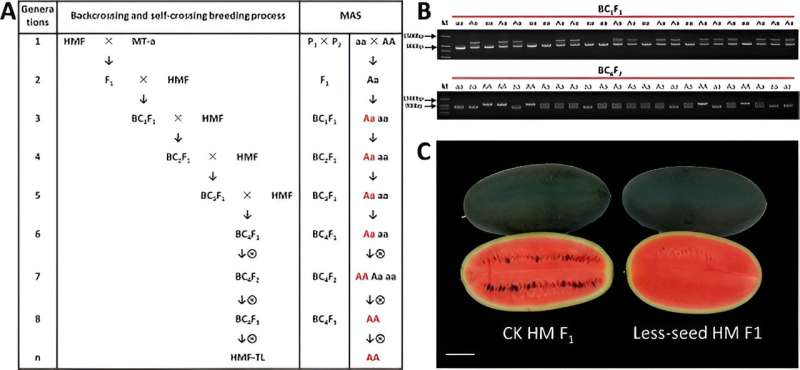
The breeding process of MAS for backcrossing to introduce translocation chromosome. (A) HMF was the backcross parent variety. The red text presented the heterozygous translocation line (Aa) and homozygous translocation line (AA) by MAS in each generation. (B) Heterozygous translocation lines (Aa) were screened on the BC1 population using the translocation recombination marker Chr10 + Chr106; Homozygous translocation lines (AA) were screened on the BC4F2 population. (C) Wild-type HMM and homozygous translocation line HMF-TL were used to prepare the hybrid combination “Less-seed HM F1”. Compared with “CK HM F1”, which used wild-type “HMM” and wild-type “HMF” as the paternal parent to prepare the hybrid group, the fruit transection section seed number ratio of “Less-seed HM F1” was significantly reduced. Credit: Horticulture Research
In an agricultural advancement, scientists have deciphered the genetic underpinnings of watermelon chromosomal translocations, the key to cultivating fruits with fewer seeds.
The global demand for seedless watermelons has surged due to their appeal to consumers. Traditional methods, such as inducing triploidy, have led production but face significant challenges like low seed production, germination rates, and poor seedling establishment. Additionally, reliance on growth regulators raises environmental and health concerns.
Based on these challenges, alternative genetic techniques are needed to enhance seedless watermelon breeding. Chromosomal translocation offers a promising solution, potentially overcoming these obstacles and paving the way for more efficient and sustainable production practices.
A team of researchers from the Chinese Academy of Agricultural Sciences, in collaboration with the Beijing Academy of Agriculture and Forestry Science, published their findings on April 22, 2024, in Horticulture Research. The study focused on developing less-seed watermelon varieties through chromosomal translocation, utilizing advanced genome sequencing technologies and molecular markers.
The study analyzed three groups of chromosomal translocation materials from different sources to develop less-seed watermelons. Using third-generation genome sequencing and fluorescence in situ hybridization (FISH), researchers identified specific reciprocal translocations between chromosomes.
For instance, naturally mutated material MT-a showed translocations between Chr6 and Chr10, while radiation-induced mutants MT-b and MT-c involved translocations between Chr1 and Chr5, Chr4 and Chr8, and a complex translocation involving Chr1, Chr5, and Chr11. These translocations significantly reduced seed counts in hybrid fruits.
The researchers also developed molecular markers to efficiently identify these translocation lines. This approach provides a robust method for breeding less-seed watermelons without the use of growth regulators, offering a sustainable alternative to traditional seedless watermelon production methods and addressing key challenges in the industry.
Dr. Wenge Liu, the study’s senior researcher, stated, “This breakthrough in understanding chromosomal translocations in watermelons opens new avenues for breeding less-seed varieties. The use of advanced sequencing technologies and molecular markers significantly enhances our ability to develop commercially viable seedless watermelons.”
The findings of this study have significant implications for watermelon breeding. By utilizing chromosomal translocation techniques, breeders can overcome the limitations of traditional seedless watermelon production methods.
This research not only paves the way for more efficient breeding practices but also has the potential to enhance the quality and yield of watermelons, meeting consumer demand and supporting agricultural innovation.
More information:
Di Jiao et al, Identification of allelic relationship and translocation region among chromosomal translocation lines that leads to less-seed watermelon, Horticulture Research (2024). DOI: 10.1093/hr/uhae087
Citation:
Cutting down on seeds: Researchers reveal innovative watermelon breeding techniques (2024, July 2)
retrieved 3 July 2024
from https://phys.org/news/2024-07-seeds-reveal-watermelon-techniques.html
This document is subject to copyright. Apart from any fair dealing for the purpose of private study or research, no
part may be reproduced without the written permission. The content is provided for information purposes only.
>>> Read full article>>>
Copyright for syndicated content belongs to the linked Source : Phys.org – https://phys.org/news/2024-07-seeds-reveal-watermelon-techniques.html










